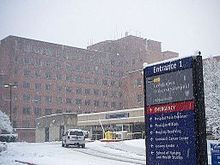MedStar Georgetown University Hospital during one of Washington’s paralyzing two-inch snowfalls.
In an obvious effort to build on its affluent clientete, “MedStar Georgetown University Hospital has applied to build a new six-story, $560 million building featuring a 33-bay emergency room, a surgical pavilion with expanded operating rooms, underground parking and a rooftop helipad, ” The Washington Post reported.
“This facility {is meant] to accommodate the natural growth in terms of our market: Northwest Washington, near-in Maryland, Chevy Chase and near-in Northern Virginia,” Richard Goldberg, M.D., president of the hospital, told The Post.
The Post noted that “MedStar’s application for approval would undoubtedly improve facilities at the existing hospital, but it comes as the District continues to struggle with broader geographic and racial health disparities.
“For instance, recent research from Rand Corp. with the support of the D.C. Cancer Consortium found far fewer providers offer cancer treatment and palliative care east of the Anacostia River, and that ‘cancer incidence and mortality among black residents of the District are dramatically higher than for white residents of the District.”’
“MedStar Georgetown is near two other highly rated hospitals that are competing for market share in Northwest D.C. and the nearby suburbs; it is two miles from George Washington University Hospital and three miles from Sibley Memorial Hospital, which has been affiliated with Johns Hopkins Medicine since 2010.”
“Meanwhile residents of the rest of the District have less enviable options for emergency and specialty medical care. Howard University Hospital, in Shaw, was the recent subject of a takeover after suffering deep financial losses. The beleaguered United Medical Center remains the only full-service hospital east of the Anacostia River.”
Patricia Quinn, director of policy at the D.C. Primary Care Association, told the paper that, in The Post’s words, “she hoped that officials from the District’s State Health Planning and Development Agency would push MedStar Health, a $4.6 billion, nonprofit health system, to do more to partner with community health organizations on cancer treatments and other services.”





